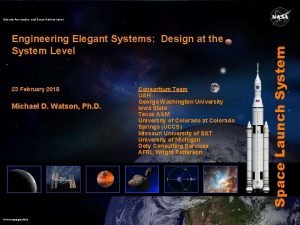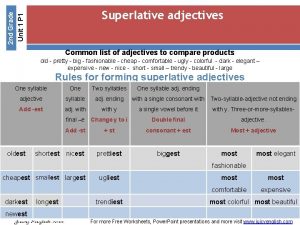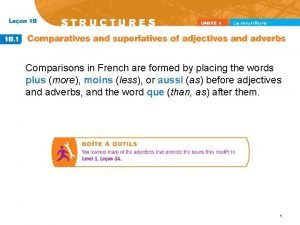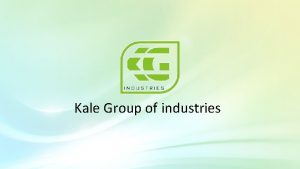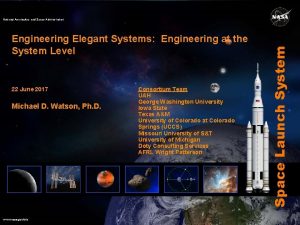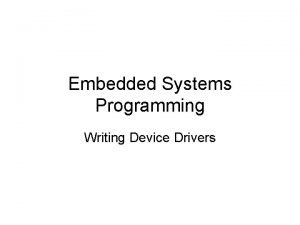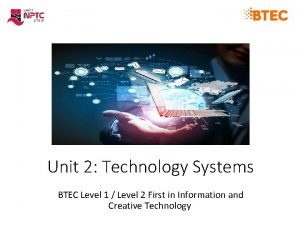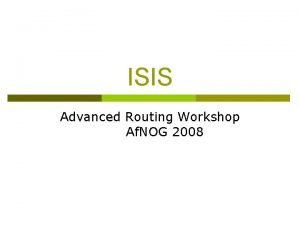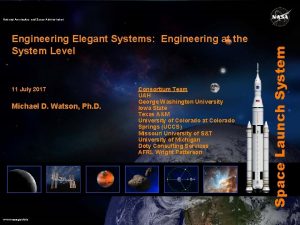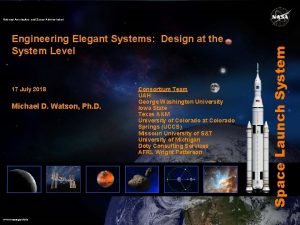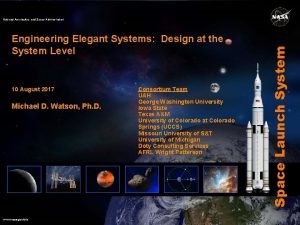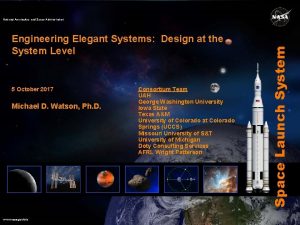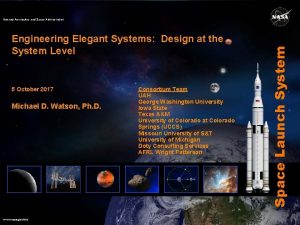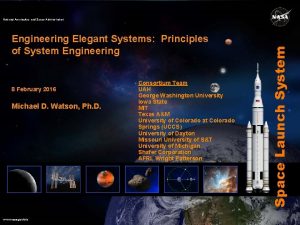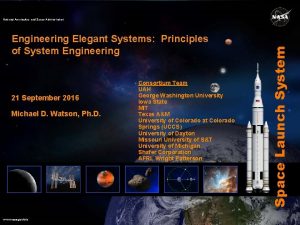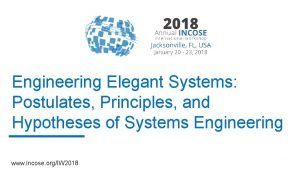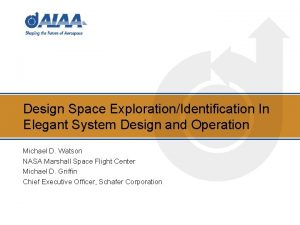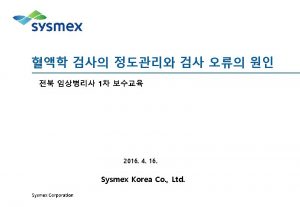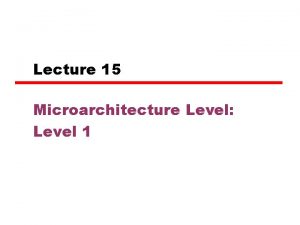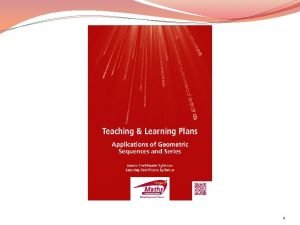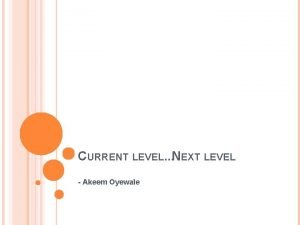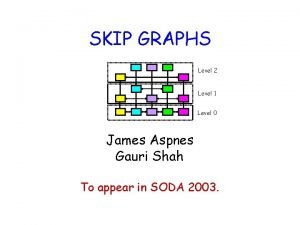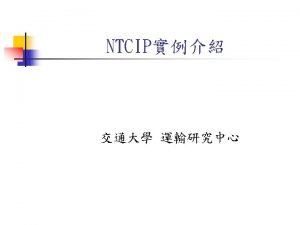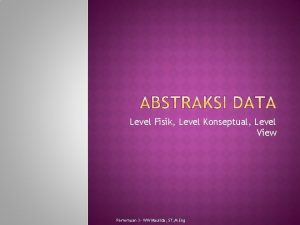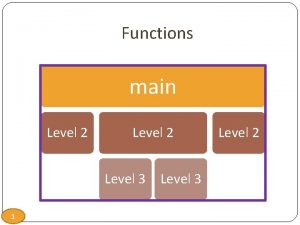Engineering Elegant Systems Engineering at the System Level



























































- Slides: 59

Engineering Elegant Systems: Engineering at the System Level 10 November 2016 Michael D. Watson, Ph. D. www. nasa. gov/sls Consortium Team UAH George Washington University Iowa State MIT Texas A&M University of Colorado at Colorado Springs (UCCS) University of Dayton Missouri University of S&T University of Michigan Shafer Corporation AFRL Wright Patterson Space Launch System National Aeronautics and Space Administration

Outline u Understanding Systems Engineering u Systems Engineering Domain • Primary ‒ System Design and Integration ‒ Discipline Integration • Supporting ‒ Processes u Products • Engineering Elegant Systems: Theory of Systems Engineering • Engineering Elegant Systems: The Practice of Systems Engineering u Summary 2

Understanding Systems Engineering

Motivation u System Engineering of Complex Systems is not well understood u System Engineering of Complex Systems is Challenging • System Engineering can produce elegant solutions in some instances • System Engineering can produce embarrassing failures in some instances • Within NASA, System Engineering does is frequently unable to maintain complex system designs within budget, schedule, and performance constraints u “How do we Fix System Engineering? ” • Michael D. Griffin, 61 st International Astronautical Congress, Prague, Czech Republic, September 27 -October 1, 2010 • Successful practice in System Engineering is frequently based on the ability of the lead system engineer, rather than on the approach of system engineering in general • The rules and properties that govern complex systems are not well defined in order to define system elegance u 4 characteristics of system elegance proposed as: • System Effectiveness • System Efficiency • System Robustness • Minimizing Unintended Consequences 4

Consortium u Research Process • Multi-disciplinary research group that spans systems engineering areas • Selected researchers who are product rather than process focused u List of Consortium Members • Schafer Corporation: Michael D. Griffin, Ph. D. • Air Force Research Laboratory – Wright Patterson, Multidisciplinary Science and Technology Center: Jose A. Camberos, Ph. D. , Kirk L. Yerkes, Ph. D. • George Washington University: Zoe Szajnfarber, Ph. D. • Iowa State University: Christina L. Bloebaum, Ph. D. , Michael C. Dorneich, Ph. D. • Massachusetts Institute of Technology: Maria C. Yang, Ph. D. • Missouri University of Science & Technology: David Riggins, Ph. D. • NASA Langley Research Center: Anna R. Mc. Gowan, Ph. D. , Peter A. Parker, Ph. D. • Texas A&M University: Richard Malak, Ph. D. • Tri-Vector Corporation: Joey Shelton, Ph. D. , Robert S. Ryan • The University of Alabama in Huntsville: Phillip A. Farrington, Ph. D. , Dawn R. Utley, Ph. D. , Laird Burns, Ph. D. , Paul Collopy, Ph. D. , Bryan Mesmer, Ph. D. , P. J. Benfield, Ph. D. , Wes Colley, Ph. D. • The University of Colorado – Colorado Springs: Stephen B. Johnson, Ph. D. • The University of Dayton: John Doty, Ph. D. • The University of Michigan: Panos Y. Papalambros, Ph. D. • The University of Texas, Arlington: Paul Componation, Ph. D. u Previous Consortium Members • Stevens Institute of Technology – Dinesh Verma • Spaceworks – John Olds (Cost Modeling Statistics) • Alabama A&M – Emeka Dunu (Supply Chain Management) • George Mason – John Gero (Agent Based Modeling) • Oregon State – Irem Tumer (Electrical Power Grid Robustness) • Arkansas – David Jensen (Failure Categorization) 30 graduate students and 5 undergraduate students supported to date 5

Understanding Systems Engineering u Definition – System Engineering is the engineering discipline which integrates the system functions, system environment, and the engineering disciplines necessary to produce and/or operate an elegant system. • Elegant System - A system that is robust in application, fully meeting specified and adumbrated intent, is well structured, and is graceful in operation. u Primary Focus • System Design and Integration ‒ Identify system couplings and interactions ‒ Identify system uncertainties and sensitivities ‒ Identify emergent properties ‒ Manage the effectiveness of the system • Engineering Discipline Integration ‒ Manage flow of information for system development and/or operations ‒ Maintain system activities within budget and schedule u Supporting Activities • Process application and execution 6

Systems Engineering Principles u Principle 1: Systems engineering is driven by the characteristics of the specific system u Principle 2: Systems Engineering integrates the system and the disciplines within the budget and schedule constraints u Principle 3: The focus of systems engineering during the development phase is a progressively deeper understanding of the interactions, sensitivities, and behaviors of the system • Sub-Principle 3(a): Requirements are specific, agreed to preferences by the developing organization • Sub-Principle 3(b): Requirements are progressively defined as the development matures ‒ Requirement Stability is an indicator of System Understanding ‒ As understanding progresses, lower level requirements are added while upper level remain stable • Sub-Principle 3(c): Hierarchical structures are not sufficient to fully model system interactions and couplings • Sub-Principle 3(d): A Product Breakdown Structure (PBS) provides a structure to integrate cost and schedule with system functions u Principle 4: Systems Engineering spans the entire system life-cycle • Sub-Principle 4(a): Systems engineering obtains an understanding of the system • Sub-Principle 4(b): Systems engineering models the system • Sub-Principle 4(c): Systems engineering designs and analyzes the system • Sub-Principle 4(d): Systems engineering tests the system • Sub-Principle 4(e): Systems engineering assembles/manufactures the system • Sub-Principle 4(f): Systems engineering has an essential role during operations and decommissioning 7

Systems Engineering Principles u Principle 5: Complex Systems build Complex Systems u Principle 6: Systems engineering influences and is influenced by organizational structure and culture u Principle 7: Systems engineering maps and manages the discipline interactions within the organization that represent the interactions of the system u Principle 8: Both Policy and Law must be properly understood to not over constrain or under constrain the system implementation u Principle 9: Decision quality depends on the system knowledge represented in the decision making process u Principle 10: Systems engineering decisions are made under uncertainty accounting for risk u Principle 11: Systems engineering is based on a middle range set of theories • Sub-Principle 11(a): Systems engineering has a mathematical basis ‒ Information Theory is a fundamental mathematical concept of systems ‒ Control Theory is a fundamental mathematical concept of systems ‒ Statistics is a fundamental mathematical concept of systems • Sub-Principle 11(b): Systems Engineering has a physical/logical basis ‒ Systems engineering incorporates the fundamental physical and logical mathematical concepts specific to the system • Sub-Principle 11(c): Systems Engineering has a sociological basis ‒ Systems engineering incorporates the fundamental sociological concepts specific to the development and operations organization 8

Systems Engineering Principles u Principle 12: Verification is a demonstrated understanding of all the system functions and interactions in the operational environment • Ideally requirements are level and balanced in their representation of system functions and interactions • In practice requirements are not balanced in their representation of system functions and interactions u Principle 13: Validation is a demonstrated understanding of the system’s value to the system stake holders 9

Methods of System Integration Goal: Techniques to Enable Integrated System Design and Assessments by the Systems Engineer

System State Variables Goal: Utilize system state variables to understand the interactions of the system in relation to system goals and system execution

System State Models u System Stage Models represent the system as a whole in terms of the hardware and software states that the system transitions through during operation u Goal Function Tree (GFT) Model • “Middle Out” model of the system based on the system State Variables • Shows relationship between system state functions (hardware and software) and system goals • Does not contain system physical or logical relationships and is not executable u System State Machine Model • Models the integrated State Transitions of the system as a whole (i. e. , hardware states and software states) • Confirms system functions as expected ‒ Checks for system hazardous, system anomalies, inconsistent state progression, missing states, improper state paths (e. g. , short circuits in hardware and/or software design) ‒ Confirms that the system states progress as stated in the system design • Executable model of system 12

System Works Booster – CS Ascent GFT

System State Machine Model u The state analysis model is split into two main components: • Manager software model • System Plant u Modeled using MATLAB Stateflow • Allows the software model to look like the Sys. ML Activity Diagrams • Allows the Systemb. Plant to be modeled as State Machines • Allows those two models to interact with each other within the MATLAB environment ‒ Facilitates the ability to generate custom analysis tools u Reads in command sequence to execute model 14

State Analysis Model for SLS M&FM Commands From Launch Countdown Doc Control (Sys. ML to Stateflow) Sensor Values § 14% of R 12 modeled §Over 7, 200 Transitions in the Vehicle and Software §Over 3, 500 States in the Vehicle Plant (State Machines) Faults Physics Values

System Value Goal: Utilize system state variables to understand the interactions of the system in relation to system goals and system execution

System Value Model u A System Value Model is a mathematical representation of Stakeholders Preferences (Expectations) for the system • The basic structure is straight forward • The sociology/psychology of representing the Preferences can be a challenge u The System Value Model is the Basis of System Validation!!! • The Requirements and Design Models form the basis of System Verification • The System Value Model forms the basis of System Validation u Constructing an SLS Value Model to compare to System Validation results • Can expand to Integrated Stack with input from MPCV and GSDO u System Value model also provides basis for a measure of System Robustness • How many mission types are supported by the system? 17

Mapping System Capability to Value & Missions Attempted “Will it work? ” (Reliability) “What can it carry? ” • Load Factors • Shock Loads • Payload Volume • Payload Services • Injection Accuracy “How expensive is it? ” • Production cost • Launch cost • etc. Missions Succeeded Total Value Delivered by Launch Vehicle 18

System Physics and System Integrating Physics Goal: Utilize the key system physics to produce an elegant system design

System Integrating Physics u Consortium is researching the significance of identifying and using the System Integrating Physics for Systems Engineering • First Postulate: Systems Engineering is Product Specific. • States that the Systems are different, and therefore, the Integrating Physics for the various Systems is different u SLS is the complex system control for the Consortium • Thermodynamic System • Other Thermodynamic Systems ‒ Crew Modules ‒ Fluid Systems ‒ Electrical Systems ‒ Power Plants ‒ Automobiles ‒ Aircraft ‒ Ships u Not all systems are integrated by their Thermodynamics • Optical Systems • Logical Systems ‒ Data Systems ‒ Communication Systems • Biological Systems u System Integrating Physics provides the engineering basis for the System Model

System Exergy Efficiency S-II Center Engine Cut-Off S-1 C Stage Separation S-II Stage Separation S-1 C Center Engine Cut-Off S-IVB Burn 1 Cut-Off LEO Insertion S-II Engine Mixture Ratio Shift S-IVB Burn 2 Cut-Off Max Q S-!VB Separation 21

Crew Module Exergy Balance: ISS ECLSS u 22

System Design and Optimization Goal: Apply system design and optimization tools to understand engineer system interactions

Multidisciplinary Design Optimization Martins, J. R R. A. , Lambe, A. B. , “Multidisciplinary Design Optimization: A Survey of Architectures”, AIAA Journal, Vol. 51, No. 9, September 2013, pp 2049 – 2075

Engineering Statistics Goal: Utilize statistical methods to understand system uncertainties and sensitivities Systems Engineering makes use of Frequentist Approaches, Bayesian Approaches, Information Theoretic Approaches as appropriate

Optimal Sensor Information Configuration u Applying Akaike Information Criteria (AIC) corrected (AICc) to assess sensor coverage for a system u Two Views of Information Content • AIC Information ‒ Information is viewed as the number of meaningful parameters • Parameters with sufficient measurements to be reasonable estimates • Fisher Information Matrix ‒ Defines information as the matrix of partial second derivatives • Information is the amount of parameters with non zero values (so provides an indication of structure) • This value converges to a maximum as the number of parameters goes to infinity • Does not contain an optimum, always increases with added parameters u AIC/AICc has an adjustment factor to penalize sensor arrangements where: number of sensors < 3 x(number of measurements) u Provides an optimization tool for use with System Models 26

Flat Plate FEA Analysis and Akaike Information Criterion (AIC) • Bias Correction Small Sample Correction Total Corrections Sli de -

Verification Process Method 1: ‘Intelligent’ Guess • Final Solution: Overlaid on Peaks Projected to XY plane Note: 2 initial guesses ‘removed’ (red) NEW points added (blue) MOST initial guesses ‘survive’ (green) Exergy-Based Information for Systems Analysis, Doty Slide - 28

Methods of System Integration Goal: System Design and Analysis

System Models Contain an Understanding of the System Value Model • State Variables Engineering Statistics Goal Function Tree (GFT) System Functions & State Variables Goals System Functions & State Variables System State Transition Model Discipline Physics Models System Integrated Physics Model (System Exergy) Multidisciplinary Design Optimization (MDO) Allow systems engineers to: • Define system functions based on the system state variables • Understand stakeholders expectations on system value (i. e. , capabilities) • Integrate discipline engineering models into a system level physics based model (e. g. , system exergy) • Design and Analyze system responses and behaviors at the System level • Magic. Draw Enterprise (Sys. ML) • Matlab State. Flow • Microsoft Excell

System Design and Integration

System Design and Models provide Knowledge Transport Medium to Operations CASE 2016: DSI Across a Full Lifecycle 32

Methods of Engineering Discipline Integration Goal: Understand How Organizational Structures influence Design and Operations Success of Complex Systems

Sociological Concepts in Systems Engineering u Specification of Ignorance is important in the advancement of the understanding of the system u Consistent use of Terminology is important for Communication within the Organization u Opportunity Structures • Provide opportunity to mature ideas ‒ Task teams, working groups, communities of practice, etc. u Socially Expected Durations will exist about the project u Both Manifest and Latent Social Functions exist in the organization u Social Role Sets • Individuals have a set of roles for their position u Cultural Subsets will form • i. e. , disciplines can be a subset within the organization • Insider and Outsider attitudes can form ‒ Be Aware of the Self-Fulfilling Prophecy, Social Polarization u Reconsiderations Process (i. e. , Reclama Process) • Provides ability to manage social ambivalence • Must be able to recognize social beliefs that may be contributing to the disagreement • Helps to avoid putting people in to social dysfunction or complete social anomie ‒ Conformity ‒ Innovation ‒ Ritualism ‒ Retreatism ‒ Rebellion 34

Information Flow u Information Flow through a program/project/activity is defined by Information Theory • Organizational communication paths • Board Structure u Decision Making follows the First Postulate • Decision Process is specific to the decision being made • Tracked 3 SLS CRs, with 3 separate task team processes, all had equally rated effectiveness u Margin is maintained by the Organization, not in the margin management tables • Biased Information Sharing • Margin Management is focused on Managing the Disciplines (informed by the System Integrating Physics) u SLS Organizational Structure was defined by the LSE as a recommendation to the Chief Engineer and the Program Manager 35

Cognitive Science u Research Goal: Identify some of the key cognitive and organizational challenges in engineering complex systems and the implications to Systems Engineering • University of Michigan, Design Science ‒ Topic: Cognitive Science Perspective of Systems Thinking • Mapping Engineering Terminology to Cognitive Science Terminology to provide a scientific basis for the engineering cognitive concepts • Investigating Mediated Learning as a method to teach system thinking Cognitive Competencies from Frank, 2012 Related Concepts from Cognitive Psychology Understand the whole system and see the big Sensemaking; information integration; mental model formation; picture generalization Understand interconnections Induction; classification; similarity; information integration Understand system synergy Understand the system from multiple perspectives Think creatively Understand systems without getting stuck on details Understand the implications of proposed change Understand a new system/concept immediately upon presentation Understand analogies and parallelism between systems Understand limits to growth Ask good (the right) questions (Are) innovators, originators, promoters, initiators, curious Are able to define boundaries Are able to take into consideration nonengineering factors Are able to “see” the future Are able to optimize Deductive inference Perspective taking (direct mapping) Creativity (direct mapping) Abstraction; subsumption Hypothetical thinking Categorization; conceptual learning; inductive learning/inference Analogical thinking (direct mapping) Information integration Critical thinking Inquisitive thinking Functional decomposition Conceptual combination Prospection Logical decision-making 36

Space Policy and Systems Engineering u Impact of Government Oversight Time Allocation Study • Motivation: Industry and government leaders agree that government oversight leads to cost growth, but there is less agreement on how much and through what mechanisms. • Research Plan: ‒ Build an empirical basis for measuring the extent and nature of the impact of oversight ‒ Non-invasive “Time Allocation Study: ” Statistically valid aggregated observations of how engineers actually spend their time throughout a product’s life cycle. • Part One: Collect time-recall diaries to develop a composite list of activities performed • Part Two: Survey Population over several months at random times per day to accurately observe amount of time spent on activities • Data collection is complete and analysis is in process ‒ Most non-value added oversight is internal company driven ‒ Government generated insight/oversight is a small % of work done (< 10%) ‒ Corporate Communication and Administrative work drive non-value added work from viewpoint of practicing systems engineers within the company 37

Percentage of total time spent on each oversight category Brainard, S. M. , Zsajnfarber, Z. , “Understanding the burden of government oversight on engineering work: adding empirical data to the debate”, submitted to Space Policy 38

System Design and Analysis Models Organizational Values Value Model Goal Function Tree (GFT) Goals • Organizational Structure & Mapping Value Attributes System Functions Agent Based Model (ABM) Discrete Event Simulation System Dynamics Model Allow systems engineers to: • Understand information flow through the development and/or operations organization • Integrate discipline information into a system level design • Analyze information flow, gaps, and blind spots at the System level • Magic. Draw Enterprise (Sys. ML) • Matlab State. Flow • JAVA • Anylogic • Extend

System Engineering Supporting Activities Process Application and Execution for the Specific System

Processes u Well defined in NASA/SP-2007 -6105 Rev 1, NASA Systems Engineering Handbook u SEMP is essential to capture appropriate application of processes to the specific system • Process application is specific to the system being developed ‒ Tailoring is not a special exception, it is the norm

Summary u Discussed approach to Engineering an Elegant System u Discussed Systems Engineering Framework and Principles • System Integration • Engineering Discipline Integration u Discussed several methods and tools for conducting integrated system design and analysis • System Integration ‒ System Integrating Physics ‒ System Design and Optimization ‒ Engineering Statistics ‒ State Variable Analysis ‒ System Value • Discipline Integration ‒ Sociological Principles and Cognitive Science ‒ Decision Making ‒ Policy and Law Application • Processes Application u Systems Engineering Approach defined in two documents • “Engineering Elegant Systems: Theory of Systems Engineering” • “Engineering Elegant Systems: The Practice of Systems Engineering” 42

Back Up 43

System Engineering Domain Goal: Engineer the System Interactions and the Engineering Discipline Interactions to produce an Elegant (efficient, effective, robust, intentional) System

System Works Goal Function Tree (GFT) Process

System-Level Representations and Relationships System Works

System Operations

Verification Process Method 1: ‘Intelligent’ Guess • Overlay extrema and inflections on contour plot of gradients • Visual illustrates concept of point locations to capture essential physics of changes in behavior of shape Exergy-Based Information for Systems Analysis, Doty Slide - 48

Verification Process Method 1: ‘Intelligent’ Guess • Initial & Final Residuals: Residual Map of Initial Guess AICc History Residual Map of Optimum Exergy-Based Information for Systems Analysis, Doty Slide - 49

Unintended Consequences u Unintended Consequences are the result of human mistakes. • Physics do not fail, we do not recognize the consequences. u Based on cognitive science, followed the work of Robert K. Merton in classifying unintended consequences. • “The Unanticipated Consequences of Social Action”, 1936 u Classification • Ignorance (limited knowledge of the problem) • Historical Precedent (confirmation bias) • Error (mistakes in calculations, working from habit) • Short Sightedness (imperious immediacy of interest, focusing on near term and ignoring long term consequences) • Cultural Values (cultural bias in what can and cannot happen) • Self Defeating Prophecy (by stating the hypothesis you induce a set of conditions that prevent the hypothesis outcome) 50

Decision Making and Communication u Track 3 Change Requests • Flight Termination System (FTS) Architecture Option 10 A (CR 53) • Data Requirements List Update (CR 70) • Core Stage Forward Skirt Umbilical (CR 82) u Sample Questions 100% 84% 0% • Was there adequate time and/or materials to perform an assessment • Were there any gaps in communication during the CR review? Yes 100% 84% 80% 100% 74% 60% u Overall Process Assessment • The decision-making process is less process dependent than expected - As long as the process matches the needs of the decision makers and an effort is made to get all needed individuals involved, different processes can be used effectively. 16% 20% No 0% 16% 20% CR 53 CR 70 CR 82 80% 0% CR 53 CR 70 CR 82 No 100% 74% 60% 18%20% Yes, minor 0% 18% 20% 0% 8% 20% Yes, major 0% 8% 20% 51

Decision Structure Information Flow u 52

SLS Organizational Structure Modeling u Interviewed 12 Marshall engineers/designers (w/J. Shelton) • Understand strategies used to integrate subsystems with each other u Common strategy across subsystems – margins • Keep some percentage of a parameter in “back pocket” as hedge for future negotiations • Biased Information Sharing • (Here, “margins” different from “safety margin”) u How does maintaining a margin affect optimality of the final design? • Model as simple 2 Player System with 3 design parameters • 15 problem test suite 53

Simulation Results u Descending margin, �� =1. 3−. 1∗�� until �� =1 Static margin, m= 1. 3 - No margin condition reaches optimality quickest Descending margin still reaches optimal, but requires more iterations Margins are an issue - Interviews highlight real-world consequences - Simulations quantify extent of the problem - Still possible to achieve optimal design with descending margin, but takes additional time to achieve Slide - 54

System Engineering Standards in Practice 55

UAH SE Consortium - Comparing the Relationship between Systems Engineering Process and Project Success in Commercial and Government Research and Development Efforts, 2012 – 2014. Agriculture Aerospace Defense and security Transportation Communications Electronics Energy Infrastructure Processes with > 3 Correlations ≥. 4 Processes with < 3 Correlations ≥. 4 Original Study Correlations 56

UAH SE Consortium - Comparing the Relationship between Systems Engineering Process and Project Success in Commercial and Government Research and Development Efforts, 2012 – 2014. Processes with > 3 Correlations ≥. 4 Processes with < 3 Correlations ≥. 4 Original Study Correlations 57

System Engineering Processes 1. Stakeholder Expectations 2. Technical Requirements Definition a. 3. 4. 5. 6. Product Validation 7. Product Transition 8. Product Operation and Sustainment 9. Technical Planning a. b. c. Technical Risk Management Technical Assessment Decision Analysis 10. Configuration Management a. b. c. Policy & Law Logical Decomposition Design Solution Definition Product Implementation Product Integration Product Verification a. Mission Context Technical Data Management Requirements Management Interface Management Technical Integration (Physics Basis Focus) Organizational Structure & Information Flow Focus on the intent of the processes not the processes themselves 58

Engineering the System 1. 2. 3. 4. 5. 6. 7. 8. a. b. c. d. e. Understand the System Application Define System Architecture and Mission Requirements Design the System Model the System Understand the System Physics, Environments, and Interactions Understand System Sensitivities and Uncertainties Integrate Discipline Designs Maintain Technical Solution within Cost and Schedule Test the System Development Verification Validation Support System Fabrication Support System Operations Mission Context Technical Integration (Physics Basis Focus) System Maintenance Responses System Obsolescence Upgrades System Capability Upgrades for New Applications System Decommissioning Planning and Execution Manage Flow of Information Through Organization Configuration Management Technical Data Management Recommend Board Structure based on Information Flow Advocate Opportunity Structures Support reclama path 9. Manage System Engineering Processes as Defined in SEMP 10. Understand Policy and Law Impacts on Technical Solution Organizational Structure & Information Flow Policy & Law 59
 Dicapine
Dicapine Elegant systems
Elegant systems Elegant system
Elegant system Irregular adjectives elegant
Irregular adjectives elegant Comparative and superlative degree of elegant
Comparative and superlative degree of elegant Bolet elegant
Bolet elegant Le superlatif
Le superlatif Kale group
Kale group System level engineering
System level engineering Hát kết hợp bộ gõ cơ thể
Hát kết hợp bộ gõ cơ thể Lp html
Lp html Bổ thể
Bổ thể Tỉ lệ cơ thể trẻ em
Tỉ lệ cơ thể trẻ em Chó sói
Chó sói Tư thế worm breton là gì
Tư thế worm breton là gì Hát lên người ơi
Hát lên người ơi Các môn thể thao bắt đầu bằng từ đua
Các môn thể thao bắt đầu bằng từ đua Thế nào là hệ số cao nhất
Thế nào là hệ số cao nhất Các châu lục và đại dương trên thế giới
Các châu lục và đại dương trên thế giới Công của trọng lực
Công của trọng lực Trời xanh đây là của chúng ta thể thơ
Trời xanh đây là của chúng ta thể thơ Cách giải mật thư tọa độ
Cách giải mật thư tọa độ Phép trừ bù
Phép trừ bù độ dài liên kết
độ dài liên kết Các châu lục và đại dương trên thế giới
Các châu lục và đại dương trên thế giới Thơ thất ngôn tứ tuyệt đường luật
Thơ thất ngôn tứ tuyệt đường luật Quá trình desamine hóa có thể tạo ra
Quá trình desamine hóa có thể tạo ra Một số thể thơ truyền thống
Một số thể thơ truyền thống Cái miệng bé xinh thế chỉ nói điều hay thôi
Cái miệng bé xinh thế chỉ nói điều hay thôi Vẽ hình chiếu vuông góc của vật thể sau
Vẽ hình chiếu vuông góc của vật thể sau Biện pháp chống mỏi cơ
Biện pháp chống mỏi cơ đặc điểm cơ thể của người tối cổ
đặc điểm cơ thể của người tối cổ Ví dụ về giọng cùng tên
Ví dụ về giọng cùng tên Vẽ hình chiếu đứng bằng cạnh của vật thể
Vẽ hình chiếu đứng bằng cạnh của vật thể Fecboak
Fecboak Thẻ vin
Thẻ vin đại từ thay thế
đại từ thay thế điện thế nghỉ
điện thế nghỉ Tư thế ngồi viết
Tư thế ngồi viết Diễn thế sinh thái là
Diễn thế sinh thái là Dạng đột biến một nhiễm là
Dạng đột biến một nhiễm là Các số nguyên tố là gì
Các số nguyên tố là gì Tư thế ngồi viết
Tư thế ngồi viết Lời thề hippocrates
Lời thề hippocrates Thiếu nhi thế giới liên hoan
Thiếu nhi thế giới liên hoan ưu thế lai là gì
ưu thế lai là gì Hổ sinh sản vào mùa nào
Hổ sinh sản vào mùa nào Sự nuôi và dạy con của hươu
Sự nuôi và dạy con của hươu Sơ đồ cơ thể người
Sơ đồ cơ thể người Từ ngữ thể hiện lòng nhân hậu
Từ ngữ thể hiện lòng nhân hậu Thế nào là mạng điện lắp đặt kiểu nổi
Thế nào là mạng điện lắp đặt kiểu nổi What is system in software engineering
What is system in software engineering Decision support systems and intelligent systems
Decision support systems and intelligent systems Embedded systems vs cyber physical systems
Embedded systems vs cyber physical systems Writing device drivers for embedded systems
Writing device drivers for embedded systems Unit 2 technology systems exam
Unit 2 technology systems exam Molecular level vs cellular level
Molecular level vs cellular level Isis protocol
Isis protocol Importance of confidence interval
Importance of confidence interval Isis level 1 vs level 2
Isis level 1 vs level 2


